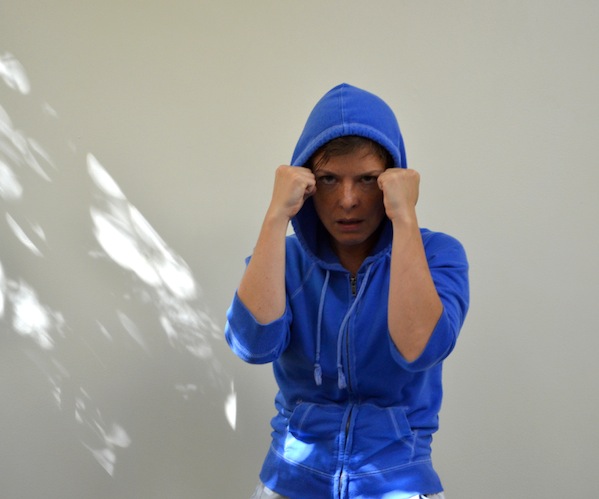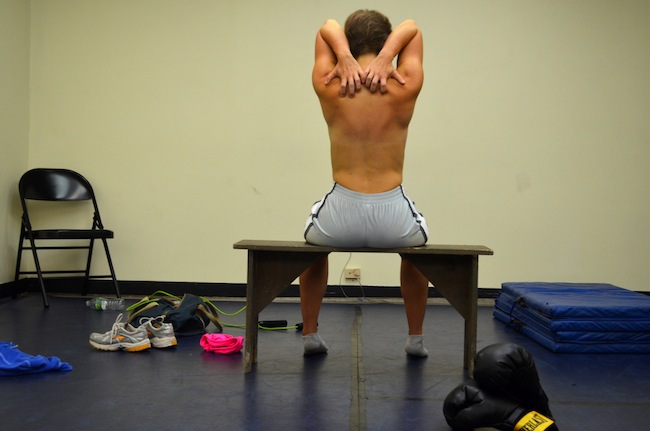Theater Review: “The Wholehearted” — Ringside at a Troubled Psyche
What makes “The Wholehearted” compelling is how it examines the metaphor of fighting as both a pubic career and as an aspect of domestic violence.
The Wholehearted, created by Stein/Holum Projects.Performed by and co-directed by Suli Holum. Written and co-directed by Deborah Stein. Presented at ArtsEmerson, Liebergott Black Box Theatre, Boston, MA through April 27.
By Robert Israel
Fighter and narrator Dee Crosby (Suli Holum) bounds onto a raised platform stage. Audience members are seated around its four sides; Jumbotron screens project enlarged images of the athlete’s grimaces, droplets of sweat, smiles, and grunts. Johnny Cash’s voice croaks out “A Boy Named Sue,” the story of a man who fights his way through life because of his feminine name. We’re primed for a similar battle as Dee — who embodies both the masculine and feminine via her boyish haircut and taut physique — grapples with issues of identity. She performs her jabs, grunts, sidesteps, and lunges. The Wholehearted is poised to tell of Dee’s triumphs and miseries.
There is no bell to signal the start of a round. But the fight, which is really an encapsulation of all the fights she has endured as a career pugilist and in her personal life, has begun.
Dramas of fighters — male and female — are not new to the stage or screen (Rod Serling’s 1956 teleplay Requiem for a Heavyweight and Clint Eastwood’s 2004 feature film Million Dollar Baby come to mind). Given all the competition, what makes this play compelling is how it examines the metaphor of fighting as both a pubic career and as an aspect of domestic violence. The play intertwines these two ideas and refuses to flinch. The character of Dee is not only battling for accolades and title trophies in the ring; she is sparring for her life at home, too, where she endures pummeling assaults by her (unseen) coach/husband Charlie Flaxon.
Actress Holum skillfully recreates this turbulently punishing world, struggling to survive in both worlds. Moments of tenderness are mixed in with the punches and scars, until the tenderness evaporates like the sweat from last night’s fight. All she is left at the end is blood and scars. A graceful fluidity develops between the scenes in the ring (on stage) and the fights that occur at home, wherein we learn of her battles, the broken nose she gives to Charlie.
Still, for all its effective theatrical moments, particularly when Holum transforms articles of clothing into illusionary characters, there are troubling aspects, too, from the first moment to the finish.
While the use of video equipment in this show is appropriate – every fighting event is televised today, so that the throngs seated in auditoriums can see every stream of blood that oozes from battered pugilists. During the production, Holum is followed around by Steven Stevo Arnoczy holding a video camera; his skillful work brings us ringside. Less effective are the scenes when Holum’s character uses a handheld video camera to film herself, ostensibly so we can see and hear her as she narrates her story. Before she develops a relationship with the audience, she bounds onstage and shoves a camera to her face. The problem is that we end up watching the television images. We disengage, at times gawking at Jumbotrons rather than experiencing her live performance. I found myself yo-yoing between the two, thinking I might miss something. An occasional televised projection would make the point just as powerfully; repeated uses of the screen are dramatically self-defeating. As the script goes through additional incarnations (it has been in workshop since 2012, and the ArtsEmerson production is the world premiere), this dependence on screens needs to be modulated, considerably.
Staying true to the country-western motif first introduced by the Cash tune at the opening, Holum, microphone in hand, croons a couple of tunes. These vocal interludes are the most effective storytelling device in the production. We are immediately transported to a country-western barroom steeped in “the mud, the blood and the beer” found in the lyrics of the Cash song. Holum is a talented singer; the songs, deceptive in their simplicity, send a few chills down our collective spines.
But there are not enough of these chills or moments of terror, taut evocations of a fighter’s season in hell. All the pouncing, jabbing, fancy foot work, the taped knuckles flailing the punching bag, the interspersed televised interview segments with a faux ESPN reporter, dull the senses. If we are meant to be taken into this savage world, we need to be yanked by the collective scruffs of our necks — necks that are not made sore as they stare at up Jumbotron images. Not that I am against technology. In fact, the creative team of Stein/Holum should consider attaching a microphone to Holum for each and every scene. At the moment, her lines are often inaudible, muffled by the thuds from her dancing, prancing and grunting on the plywood stage.
The Wholehearted is a work in progress. It has the potential to be an even more effective work for the stage, but it first must get out of its own way so it can let the audience in.
Robert Israel writes about theater, travel and the arts, and is a member of Independent Reviewers of New England (IRNE). He can be reached at risrael_97@yahoo.com


